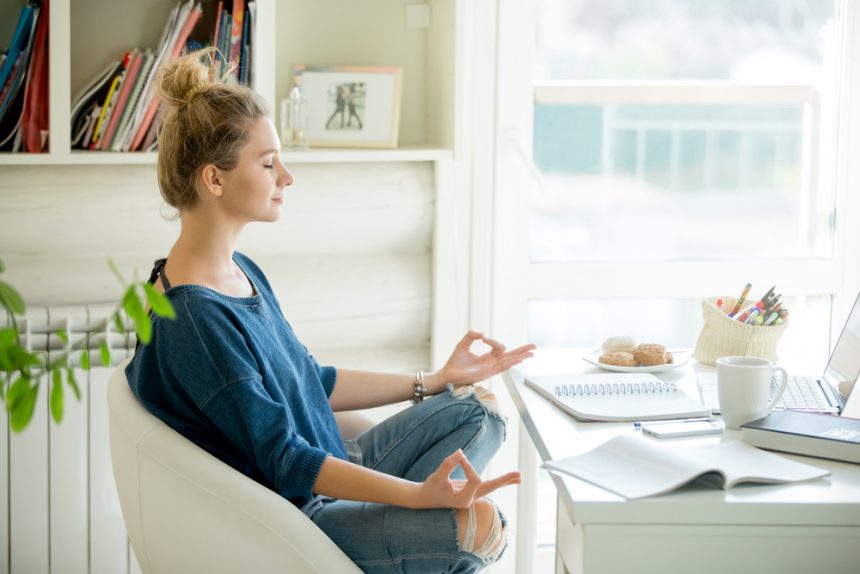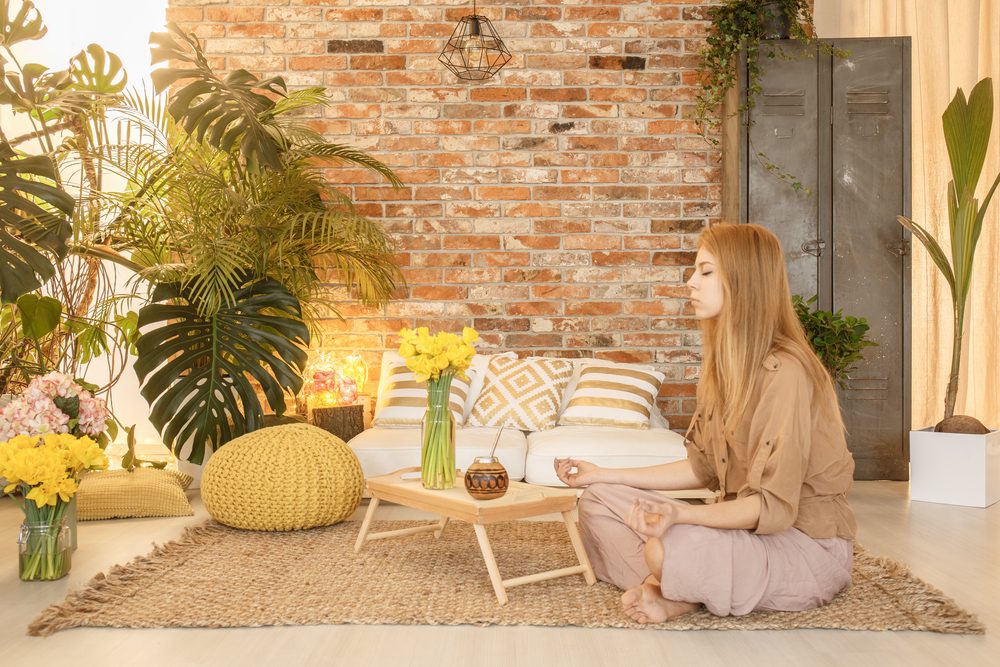Over the past five years, meditation’s popularity has increased threefold, according to a study by the Center for Disease Control. It’s no wonder. The benefits of meditation continue to be unveiled as new research proves the usefulness of the practice.
Is meditation right for you? For many Americans, the answer is a resounding, “Yes!”
There are many ways to practice meditation, but having a room in your house designed specifically for relaxation and mindfulness can do wonders for your mental health. We’ll give you the top tips you’ll need to make that room as functional and soothing as possible.
What is Meditation?
Meditation is all about two things: awareness and perspective. It isn’t therapy, although it can definitely have mental health benefits. It isn’t attached to a religion either, although certain religions practice forms of meditation in their services.
You can think of meditation as training for the mind. Similar to exercise for the body, practicing mindfulness and gaining perspective can give you a healthy mental balance during all the chaos around you.
An important note: there are different ways of approaching meditation. None of them are “better” or “correct”, so you have to find the one that fits you best.
University of Wisconsin neuroscience lab director Richard J. Davidson, Ph.D., told The New York Times, “In the Buddhist tradition, the word ‘meditation’ is equivalent to a word like ‘sports’ in the U.S. It’s a family of activities, not a single thing.”
Forms of Meditation
There are many different types of meditation, but we’ll focus on two for now.
Concentration Meditation
Remember when we said meditation is about two things: awareness and perspective? Concentration meditation is all about focus, which falls in the “awareness” category. Where are you focusing, and how long can you hold your focus?
If you find yourself drifting off in thought while you work, you might start with concentration meditation. It’s very simple. You just focus on something—this can be your breath, a candle, a garden, a mental image—and try to do it for as long as possible. You can even count objects around you.
In the beginning, it’ll be tough and you probably won’t last very long without intrusive thoughts interrupting you. Don’t be frustrated. Before long, you’ll find that it gets easier to concentrate and you can hold your focus for a longer time period.
Mindfulness Meditation
The second form of meditation we’ll cover is called mindfulness. This is a popular form, so you’ve probably heard of this one before. Mindfulness is about exactly what it sounds like—learning how to stay mindful of your surroundings, feelings, and place in the world.
This form of meditation starts with clearing your mind and letting intrusive thoughts come and go. This is called the “monkey mind” technique. The technique accepts that the human mind is like a monkey. It reaches out to grasp ideas and thoughts. It’s very difficult to let your mind go completely blank, so instead, mindfulness teaches to simply be aware of those thoughts.
It doesn’t stop with thoughts, however. It’s also about being aware of your body in space. Learning where you are in the world and how you’re feeling physically and emotionally at that moment will help you work on the second objective of meditation: perspective.
Guided Meditation vs. Unguided Meditation
You’ve probably heard of these two different methods for meditating. But is there a difference? Which is better?
Guided Meditation
Guided meditation involves using an outside party to direct your thoughts. This could be in-person, but most people use guided meditation apps that contain audio recordings.
There are pros and cons to both types, but we’ll start with the pros:
First, guided meditation is easier. Yep. It’s just straight-up easier to do. When you have someone talking into your ear and providing guidance, it’s a much simpler task to stay focused or mindful.
It’s also a great way to start. Because so much of meditation is conceptual, it’s difficult to find the starting line. If you’re the type of person who enjoys a structure and needs a framework to begin something, you would benefit from this method.
There are cons, however:
Guided meditation can handicap your growth. Some people consider it “meditation on training wheels” because it makes learning the practice easier, but it isn’t the best for long-term development. When you have a voice in your ear telling you what to do, you might start relying on it.
Second, it removes your ability to meditate anytime and anywhere. You’ll always be tied to an audio recording, which limits your options. When you’re feeling anxious and you left your headphones at home, it’ll be difficult to use what you learned.
Unguided (Silent) Meditation
Unguided or silent meditation is exactly what it sounds like. There is no audio, no guide to help you through the process. It’s just you and your thoughts.
Here are the pros:
You’ll get to experience the full, unadulterated meditative experience. No one is telling you what to do, how to think, or where to go with your session. You get to decide how to approach it, which can lead to more impactful discoveries down the road.
You also don’t need any devices to do it. Phones run out of battery and headphones get left behind. Unguided meditation is just you and your thoughts…
…which is also one of our cons:
It’s just you and your thoughts. It’s easy to be distracted while you’re meditating, which is why it’s important to have a soothing space for meditation. We’ll get into room design below to solve that issue.
Unguided meditation is also difficult for beginners. It’s not impossible, but it’s definitely harder for newcomers to learn. Without a third party teaching you how to move through the session, it’ll be more difficult to get going.
There is no right answer for which method you should choose. If you like to have a structure while learning something new, guided meditation might be best for you. If you are confident you can start learning on your own, go for silent meditation instead.
Benefits of Meditation
Meditation has a long list of benefits, all of which are backed up by peer-reviewed research studies. We’ve taken the liberty of listing them for you here:
- Reduces stress
- Increases psychological functioning and sense of well-being
- Enhances areas of the brain associated with processing and empathy
- Improves your ability to pick up on social cues, which improves relationships
- Increases cognition and focus
- Enhances creativity
- Improves memory
- Helps function of decision-making centers in the brain
- Can help people overcome addiction
- Improves cardiovascular health and decrease the risk of heart disease
- Helps you reach “flow state” easier
- Reduces physical and emotional pain
How is Meditation Practiced?
The short answer: anywhere, anytime. You can meditate on the train, in a meeting, or in the park.
That said, many people find the distractions of public environments detract from their experience. For that reason, there is a growing trend of people designing “meditation rooms” in their homes. It’s an easy way to dedicate space for such an important mental exercise. Think of it as a home gym for your brain.
Home Design
Ideally, you have a room in your home you aren’t using. This is the best option, but what if you don’t have much space?
Don’t worry—we have you covered. Even if you don’t build out a full meditation room, you can create a meditation “nook” or implement some of these tips at your desk or office. You can also use an outdoor space like a garden or patio.
Furniture
It’s important to remember the key design rule in meditative spaces—no stress. That means no clutter, either. Your room should be pretty stark. Use a few pillows, a yoga mat, a blanket, and maybe a table as furniture.
It’s very important that you don’t overdo this part. Visual clutter is distracting and can take you out of your peaceful mental state.
There are certain decorations that can help you relax. Plants, for example, are soothing to the eye. There’s a reason so many people have greenery in their homes. It’s relaxing to have a little piece of nature there with you, and it’ll help you feel more connected to the world around you.
Color Impact
Colors are known to have an impact on our mood, so it’s important that you choose the color of your meditation room wisely.
For example, you should avoid red at all costs. That color stimulates excitement and energy, which will keep your mind racing and make it difficult to relax into a meditative state.
Blues, on the other hand, have been shown to calm the heart rate and relax you. Some people find dark blues depressing, but others find light blues too severe. Choose what you feel will suit you, but if you’re in doubt, opt for a medium blue to bridge the gap.
Yellow is another great option. It stimulates happiness and will lift your mood while you meditate.
Air Quality
The quality of the air you’re breathing can make a difference in how well you’re able to relax.
Aromatherapy is a common practice used in conjunction with meditation to enhance the overall experience. If you aren’t too sensitive to scents, lavender is a great scent to calm you down and get you ready to meditate.
If you live in an urban area, it’s a good idea to invest in an air purifier or humidifier. Since so much of meditation centers around breathing, it’s important to make sure the air you’re breathing is clean.
Speakers and Technology
One of the most common ways to enhance your meditative experience is with sound. Soft waterfalls, ocean waves, twittering birds, and twinkling bells can help you overcome the distractions around you—especially in an urban environment.
Poor audio quality can have the opposite effect. You don’t have to invest in the highest-quality speakers on the market, but be sure to test them before you buy them. With bad speakers, your brain will have a hard time suspending its disbelief at the presence of ocean waves in the middle of Manhattan.
Final Thoughts
When you’re designing a meditation room, the choices you make are very subjective. Remember to do what feels right and relaxing to you. What works for others may not feel very serene to you, so choose colors, spaces, furniture, and sounds that soothe your mind and leave you ready to meditate.








